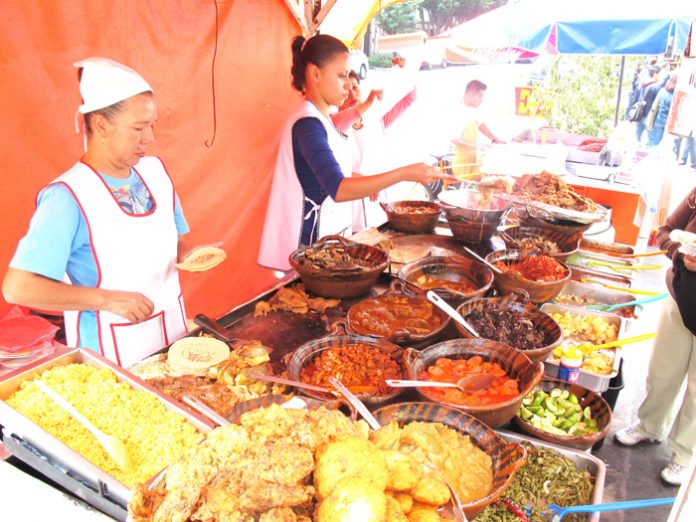Clever combinations of traditional and contemporary flavors and techniques are transforming an ancient cuisine.
Known by locals as ‘El DF’, for Distrito Federal, Mexico City has more than 15,000 restaurants. With regional food from every state, as well as local specialties and Mexican nouvelle cuisine, there is something for every appetite and budget. Some of the best regional dishes available in the city are served by Chef Titita Ramirez at El Bajio, a small restaurant in the Axcapotzalco colonia, or neighborhood. If you want to sample Oaxacan specialties, try Casa Neri in Colonia Portales, south of the city center, where customers eat outdoors on an attractive colonial patio. And, for a wide selection of Puebla’s famous moles, (delicious sauces made with chilies, spices, and chocolate) and pipian (a similarly piquant sauce often with a base of pumpkin or sesame seeds), go to Ikaro in Colonia Narvarte. Nouvelle cuisine is best sampled at Izote in Colonia Polanco, north of Chapultepec Park, where the menu borrows cleverly from pre-Hispanic culture with such dishes as squash blossom soup and fragrant shrimp in hibiscus mole sauce. But for the genuine pre-Hispanic cuisine of the Aztecs, visit Fonda Don Chon in Centro, the historic city center, where fried grasshoppers, worms, armadillo in mango sauce, and ant roe are served to adventurous diners.
When to go: Mexico City is a great food destination any time of year
Planning: Be sure to make a reservation and check if the restaurant has a dress code. Mexico has a comprehensive public transportation system and plenty of taxis. Late at night, official secure taxis —taxi seguro—operate. Restaurants, bars, and clubs should be able to phone for one or provide a list of numbers.
Websites: www.visitmexico.com, www.mexconnect.com

Meal times in Mexico
- Desayuno is a light breakfast, usually consisting of sweet rolls and coffee. For an authentic Mexican morning meal, try tamales sold at street stands.
- Almuerzo is brunch, a mid-morning meal typically consisting of an egg dish such as huevos rancheros or chilaquiles (fried tortilla strips smothered is salsa and topped with chicken and cheese). Most restaurants serve almuerzo by about 10am
- Comida is the main meal, eaten between 2 and 4pm. Look for comida corrida, literally “meal on the run,” fixed-price specials.
- Merienda is a light, early-evening meal, usually consisting of coffee and pastries at a café or cocktails and snacks at a bar.
- Cena is a late, light supper eaten at about 9 or 10pm.
Tropical Fruit Treats
- Veracruz and the surrounding area are paradise for lovers of tropical fruit. Whether eaten fresh, or enjoyed in the form of cold helados, paletas, or licuados, the fruits include many that are familiar —mangoes, coconuts, papayas (or pawpaws), and pineapples. Others may be a new experience.
- About the size of a grapefruit, the cherimoya has a segmented green skin and succulent white flesh. The flavor is fragrant, with hints of strawberry. If you eat a cherimoya fresh, beware of the large black pits
- The guanabana (or soursop) is recognizable by its spiky green skin. The creamy white flesh is often pulped and used in licuados or helados.
- The pink or orange flesh of the mamey has a sweet pumpkin-like flavor. Try it fresh, with a little lime juice squeezed over it.
- A favorite in licuados, the zapote blanco looks a bit like a large plum. The flavor of its yellowish-white flesh is often compared to a combination of peaches and vanilla.

Mexico: Veracruz
The Street food in this Gulf Coast port city draws on an exotic mix of indigenous, Spanish, and Afro-Caribbean ingredients.
In the sultry climate of Veracruz, the best time to be outdoors is at night, when the air vibrates to the African-inspired rhythms of the ubiquitous musica-tropical. And as you explore the waterfront or check out the nightlife around the main plaza, what better way to keep yourself going than with mouthwatering cold snacks-licuados (fruit shakes), palates (frozen fruit bars), and countless kinds of helado (Ice cream).
Since its founding by the conquistador, Hernan Cortes, in 1519, Veracruz has been Mexico’s main eastern port and a major gastronomic crossroad. Olive oil and panoply of Mediterranean herbs and spices arrived from the Old World to add new layers of flavor to native Central American ingredients, such as corn, chilies, and different kinds of bean. The local Totonac people were the first to cure vanilla beans for culinary use. Later arrivals included pineapples, sugarcane, peanuts, and the banana’s savory cousin, the plantain.
Today, this varied legacy is evident all around you. Puff pastry turnovers, called bolovanes, filled with a choice of crabmeat, tuna, or pineapple, tempt you from stalls along large thoroughfares. In the morning, freshly boiled shrimps straight from the docks set your taste buds dancing. Sample tamales wrapped in banana leaves, fried tortitas made from plantain dough filled with black beans, or thick corn tortillas, called picaditas, topped with salsa and cheese. And for a drink that packs a punch, try a toro-a milk shake laced with the local aguardiente, a potent sugarcane liquor.
When to go: The hot, humid climate makes fall and winter the best times to visit. Carnaval, the city’s major celebration, is held during the week before Lent. If traveling in summer, try for July’s Festival International Afrocaribeno, a two-week celebration of African music and dance in the Americas.
Planning: Spend an afternoon in the town of Boca Del Rio, south of Veracruz. Its seaside restaurants offer the region’s best fish and shellfish, some flavored with the local herb, acuyo. Take a day to visit Papantla, north of the city, to see the pre-Hispanic site of El Tajin, buy vanilla beans, and watch the astonishing dance of the voladores (flyers), in which four men attached by ropes to a pole fly through the air.
Websites: www.planetware.com, www.carnival.com, www.mexconnect.com

















